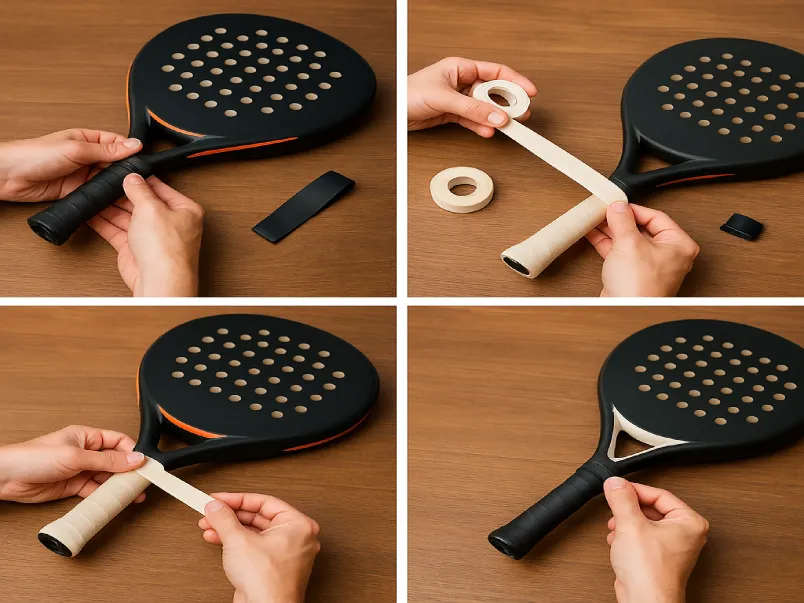Padel is an exciting sport that combines elements of tennis and squash, offering a fun yet demanding workout. If you’re a regular player, you know that maintaining your padel racket is essential for performance and comfort. One of the most important yet often overlooked aspects of racket care is the grip. Over time, the grip can become slippery, lose its feel, or even start to smell. This negatively impacts your game by affecting control and comfort, and it can even lead to blisters.
Fortunately, fixing or replacing your padel racket grip is a simple and cost-effective DIY task that will make a world of difference in your game. In this guide, we will take you through everything you need to know about maintaining, replacing, and customizing your padel racket grip at home. From understanding the different types of grips to step-by-step instructions on how to replace them, we’ve got you covered.
I. Understanding Your Grip: The Basics
What is an Overgrip?
An overgrip is a thin, replaceable wrap that is applied on top of the original grip. It is primarily used for comfort, absorbency, and providing extra tackiness for better hold. Overgrips are designed to be replaced frequently, usually after a few games or once they begin to lose their feel or become slippery. They are commonly used to enhance the grip’s performance, prevent blisters, and improve overall control during play.
Purpose of an Overgrip
Overgrips offer several advantages:
- Absorbency: Helps to wick away sweat during intense matches.
- Tackiness: Provides a better, firmer grip, reducing slippage.
- Customization: You can personalize your grip for comfort and style.
What is a Replacement Grip?
A replacement grip is a thicker, cushioned grip that replaces the racket’s original handle grip. Unlike the overgrip, the replacement grip is meant to last longer and completely changes the feel of the racket handle. It’s more durable and can make your racket more comfortable to hold, especially for players with larger hands or those looking for more cushioning. Replacement grips are generally replaced less often, typically when they begin to show wear or lose their cushioning.
Purpose of a Replacement Grip
Replacement grips provide:
- Comfort: The additional thickness adds comfort, especially during long play sessions.
- Customization: You can choose grips that fit your hand size or playing preferences.
- Durability: Typically more durable than overgrips, providing long-lasting performance.
Grip Tape
Grip tape is used to secure the grip in place, ensuring that it stays tightly wrapped around the racket handle. It’s a short adhesive strip that holds the grip firmly at the top or bottom of the racket. Some grips come with their own tape, but you may also use separate grip tape for a more secure finish.
II. What You’ll Need: Your DIY Toolkit
Before you dive into replacing or fixing your padel racket grip, make sure you have the following items on hand:
Essential Items
- New Overgrip or Replacement Grip: Depending on which type of grip you’re replacing, make sure you have the correct one.
- Scissors: To trim the overgrip or replacement grip to the right length.
- Grip Tape: Often included with the grip, this will help secure the grip in place.
Optional but Helpful Items
- Sharp Knife/Box Cutter: An alternative to scissors for precise cutting, especially for thicker grips.
- Cleaning Wipes: Clean the handle and remove any dirt or sweat before applying the new grip.
- A Clean, Flat Workspace: It’s essential to have a tidy and stable workspace to ensure a smooth process.
III. Step-by-Step Guide: How to Replace an Overgrip (The Most Common Task)
Replacing an overgrip is a straightforward process, and it’s something most padel players do regularly to maintain their racket’s feel. Here’s a step-by-step guide to help you:
Step 1: Preparation
- Remove the Old Overgrip: Start by carefully unwrapping and removing the old overgrip from your racket handle. It may come off easily, or you may need to peel it away in sections.
- Clean the Base Grip: Use a wipe or a damp cloth to clean the handle underneath the old grip. Make sure there is no dirt, sweat, or residue on the base grip. Let it dry completely before proceeding.
Step 2: Locate the Starting Point
Look for the sticky starter tab or the tapered end of your new overgrip. This is typically the part that is glued or taped to the handle first.
Step 3: The First Anchor
Place the tapered end of the overgrip at the bottom of the handle (near the butt cap) at a slight angle. Wrap it around once to secure it firmly, ensuring it stays in place.
Step 4: The Wrapping Technique
- Maintain consistent, slight tension as you wrap the overgrip. The key here is not to pull too tight (which can tear the overgrip) or too loose (which can cause the grip to feel uneven).
- Overlap each wrap by about 1-2mm to ensure an even and consistent layer.
- Continue wrapping diagonally up the handle to maintain an even distribution of tension and avoid lumps.
Step 5: Finishing the Wrap
As you near the top of the handle, you will be left with a long strip of excess grip. This is normal, and you’ll need to secure it properly.
Step 6: Securing the End
Tear off the backing from the finishing tape that comes with the overgrip. Wrap this tape tightly around the top of the grip to secure the end. This will prevent the grip from unraveling during play.
Step 7: The Final Check
Once the grip is securely wrapped, check the grip for any inconsistencies. Feel the surface to make sure there are no bumps or loose areas. If everything feels smooth and secure, you’re done!
IV. How to Replace a Base Grip (Replacement Grip)
Replacing a base grip is a slightly more involved process but can significantly change the feel of your racket. Here’s how you can replace the base grip:
Step 1: Remove the Old Grip
Carefully peel off the old base grip. Be sure to remove any adhesive or tape residue that may be left on the handle.
Step 2: Align the New Grip
Take the new replacement grip and align the tapered end with the bottom of the handle, just like you did with the overgrip.
Step 3: Wrap with Care
Use the same overlapping technique to wrap the new grip around the handle. Since the replacement grip is thicker, you may need to apply a little more pressure to ensure it wraps neatly and tightly.
Step 4: Cut and Secure
Once you’ve reached the top of the handle, trim any excess material with scissors. Then, use the provided tape (or a larger piece of grip tape) to secure the end firmly. This will prevent it from unraveling during play.
V. Pro Tips and Common Mistakes to Avoid
Pro Tips
- Tension is Key: Don’t pull the grip too tight or too loose. Consistent tension will ensure an even wrap without damaging the grip.
- Overlap Consistency: The more consistent your overlap, the smoother the grip will feel. Avoid wide or uneven overlaps to maintain a uniform texture.
- Experiment with Wrapping Direction: While most players wrap from the bottom up, some prefer wrapping from the top down. Feel free to experiment to find what works best for you.
Common Mistakes to Avoid
- Using the Wrong Tape: Avoid using duct tape or electrical tape. These types of tapes aren’t designed to handle the sweat or friction involved in padel, and they can leave sticky residue.
- Wrapping Too Thick: If you use both a thick replacement grip and a thick overgrip, the racket handle might feel too bulky. Choose a grip that suits your hand size.
- Rushing the Start: A poorly anchored grip will unravel during play. Always take your time to secure the first few wraps.
VI. FAQ: Your Grip Questions Answered
How often should I replace my overgrip?
It’s a good idea to replace your overgrip every 2-3 playing sessions or as soon as it starts feeling slippery or loses cushioning.
What’s the difference between tacky and absorbent overgrips?
- Tacky Overgrips: Ideal for players with dry hands or for indoor play. They provide a firm grip.
- Absorbent Overgrips: Best for players with sweaty hands or for outdoor play. They absorb sweat and prevent the grip from becoming slippery.
Can I build up the grip size?
Yes, you can increase the size of your grip by using a heat sleeve or grip enlarger underneath the overgrip.
My grip feels lumpy, what did I do wrong?
This is usually due to inconsistent tension or overlap. Simply unwind and rewrap the grip more carefully.
VII. Conclusion
Replacing your padel racket grip may seem like a small task, but it can significantly enhance your comfort, performance, and overall experience on the court. With just a few tools and some practice, you can easily fix or replace your grip in under 10 minutes. So, grab your gear, follow the steps in this guide, and enjoy a fresh new feel for your racket that will improve your game.
FAQs
1. How often should I replace my padel racket overgrip?
It’s recommended to replace your overgrip every 2-3 playing sessions or as soon as it begins to feel slippery, loses its cushioning, or becomes uncomfortable to hold.
2. What’s the difference between a tacky and absorbent overgrip?
- Tacky Overgrips: Ideal for dry hands or indoor play, providing a firm, sticky feel.
- Absorbent Overgrips: Perfect for sweaty hands or outdoor play, as they absorb moisture and help prevent slipping.
3. Can I build up the size of my grip?
Yes, you can increase your grip size by using a heat sleeve or a grip enlarger beneath the overgrip, which will add thickness to the handle.
4. Why does my grip feel lumpy after wrapping it?
Lumps in your grip usually occur due to inconsistent tension or overlapping. To fix this, unwind and rewrap the grip with even pressure and consistent overlaps.
5. What type of tape should I use to secure the grip?
Always use grip tape provided with the overgrip or replacement grip. Avoid using duct tape or electrical tape as they are not designed for racket grips and can leave residue.
6. How do I know if I need a replacement grip instead of an overgrip?
If your current grip feels too thin or lacks cushioning, or if you’re looking for a more customized feel with a thicker handle, it’s time to replace the base grip with a replacement grip.




